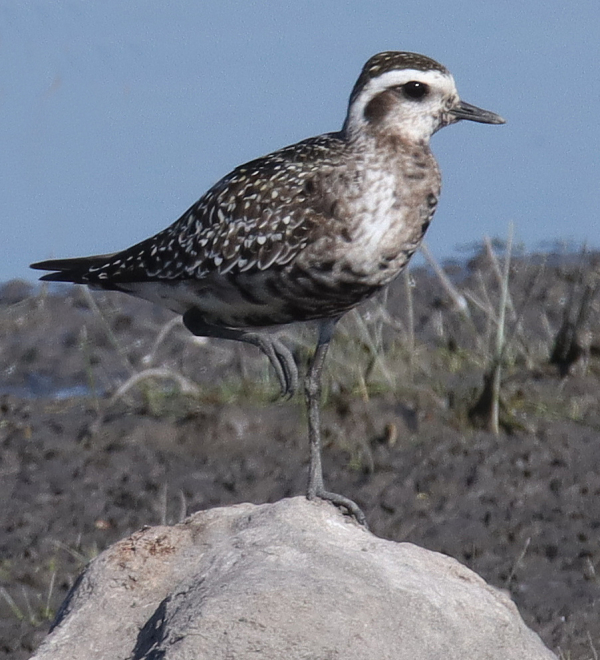 The surprise of the week was the sighting of 3 American Golden Plovers that made a migration stopover on their way from the Arctic to Argentina. 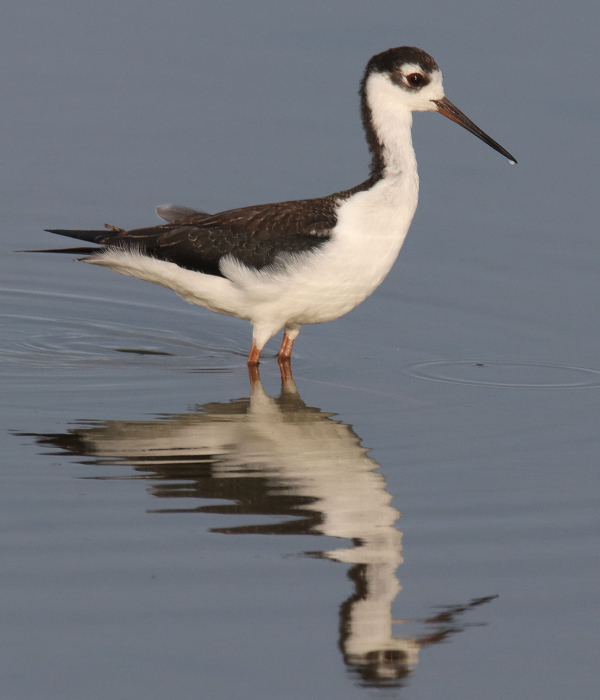 Two Black-necked Stilts, new to the area, continue to raise questions about their origin. Two days later, an adult male was observed with the 2 young stilts, indicating they were a family group on hand during the post-fledging period. 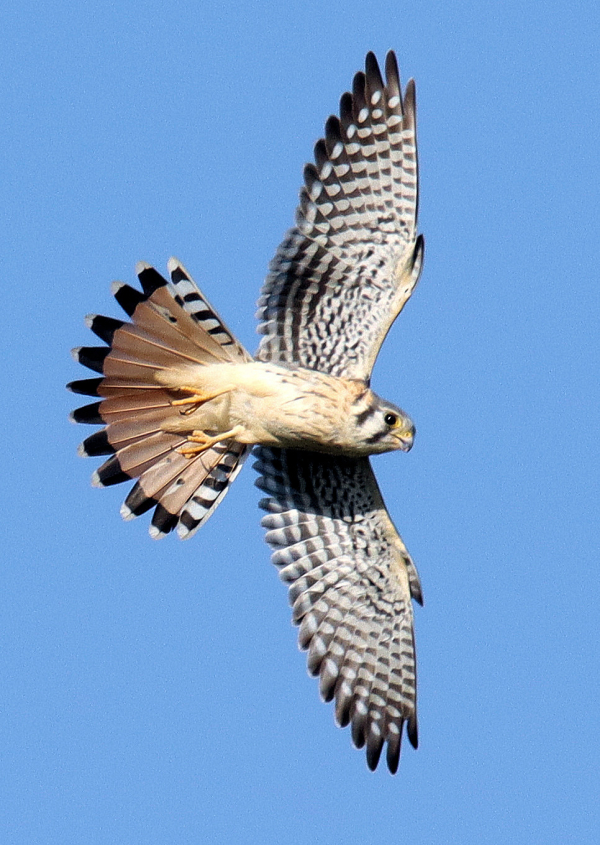 A representative photo of 1 of 9 American Kestrels active in playful flights above a linear grove of tall trees. 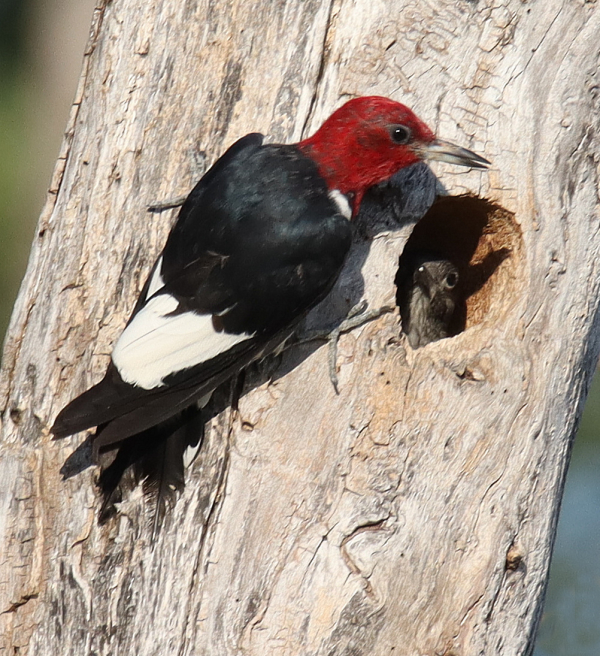 A familiar adult Red-headed Woodpecker revealed its nesting cavity, where it was feeding at least 1 nestling. 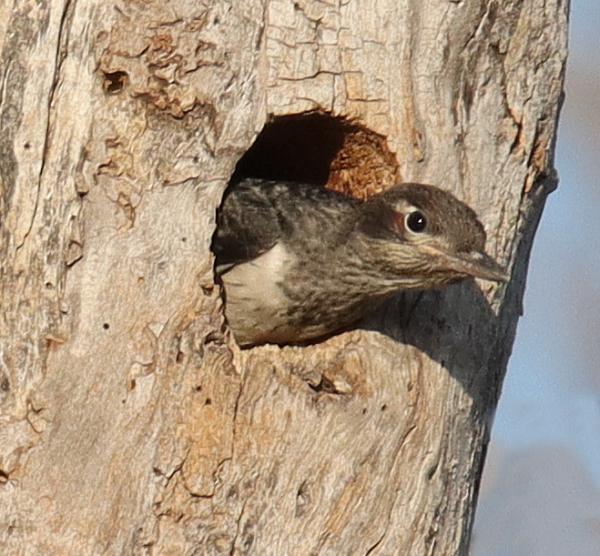 A fun view of a gray-headed nestling, soon to be a fledgling. 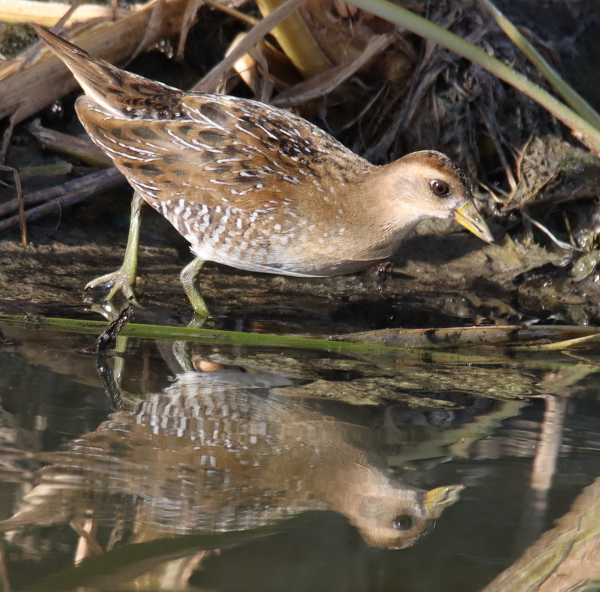 While Paul was photographing a young Ruddy Duck, a young Sora made a surprise appearance, and even stepped into the afternoon sunlight for just a moment before vanishing behind cattails. |
It seemed unusual to be photographing 2 Black-necked Stilts in my local area, at Charo Marsh, but maybe I need to get used to it considering the species has been regular an hour to the east at the State Line marshlands. And I did see a lone fledgling Black-necked Stilt at Charo Marsh about a month ago, which made me wonder where it originated. From my vantage point, these 2 stilts lacked the scalloped coloring on the edge of the black feathers, indicating they were not recent fledglings – they also were not adult males, which have dark-black back and neck plumage – apparently they were females.
However, when I had a chance to look at the photos I took of the stilts, including some really nice images, I quickly realized both birds’ black plumage showed fine scalloping, indicating they were indeed fairly recent fledglings. The young stilts were completely trusting and foraged in the shallows along the shoreline in my direction, providing excellent photo ops in the prime late afternoon sunlight – hooray!
My impression is that the birds were not hatched and raised at Charo Marsh, or in the area, but I could be wrong – it’s happened before. But now, post-nesting, it’s natural for many birds to disperse some distance from their nesting territories, and they can and do move in any given direction. And I’m going to bet these Black-necked Stilts came from a location beyond North Dakota.
According to All About Birds and Birds of the World, the closest populations nest in western Montana and central Colorado, or the Gulf Coast of Texas, but a closer look at a map of eBird sightings shows a bit of a stronghold from the State Line area south of Ludden (North Dakota) to Sand Lake Refuge along the James River in South Dakota. But eBird shows a sprinkling of sightings throughout the Dakotas, southern Minnesota, and beyond, so the species is obviously prone to dispersing beyond its normal range.
That aside, it sure was exciting to find and photograph these 2 Black-necked Stilts after a brief distant look at the fledgling weeks ago. I visited Charo Marsh an hour before and spent a little time there to photograph a few Pectoral Sandpipers as the only other shorebird on hand was a distant Greater Yellowlegs and the ever-present numbers of Killdeer. After making a big rectangular drive I returned to Charo, where I didn’t see anything out of the ordinary, so began photographing the flights of Franklin’s Gulls that were making low foraging flights to intercept flying insects. After about a minute my eye was drawn to the shoreline, where I was surprised to see the 2 Black-necked Stilts, which I now know were recent fledglings, thanks to careful photo examination.
During my Friday afternoon drive I also observed an adult Bald Eagle, 5 American Kestrels including 3 together, a Grasshopper Sparrow, and a sprinkling of Franklin’s Gulls that seemed to extend across the 20-mile expanse I covered. In fact, Franklin’s Gulls were very active in the air space above my home and the surrounding area, with the gulls foraging from just above the tree tops and up to 25 feet higher – apparently where the flying insects were active.
Golden Plovers? Seriously?
Saturday afternoon’s sunshine made me head for the dual-hotspots of the State Line and Hecla Marsh, a bit more than an hour away, but the local birds had other plans for me. Wanting to quickly check Charo Marsh on the way to see if the Black-necked Stilts were on hand, I ascertained there were no stilts – only a Greater Yellowlegs where I left the stilts the evening before, but there were even more Killdeer than usual, so I counted 30, then repositioned 50 yards ahead where there were even more Killdeer on a muddy edge of the marsh. As I counted another 30, I realized my binocular view was filled with 3 American Golden Plovers! What!
I grabbed my camera and focused on the trio to document them and hopefully get some nice images of each individual during a surprise stop on their marathon migration from the Arctic tundra to northern Argentina. It was clear that each of the Goldens was in mid-molt, still showing some black plumage on their bellies that indicated they were all adults. One even had some black feathers on its face surrounding its bill, and there was a slight glow of gold on their dorsal plumage. The Golden Plovers were not very animated, probably tired and in resting mode, but they seemed to prefer standing on rocks over standing on the mud, in spite of the 90 degree heat.
Suddenly, about 8 Killdeer took flight, a small number of the estimated 160 on hand, but the commotion seemed to alert the Goldens. The plover on the left opened its wings and took flight as it called, with the other 2 American Golden Plovers immediately joining the exodus, flying at a steep angle upward, winging southeast and quickly out of sight. That was my first fall sighting of this impressive species in North Dakota, and I’ve only seen them once before during fall, in northwest Wisconsin more than a decade earlier.
I had to wonder, what is it about Charo Marsh that is so attractive to locally rare shorebirds – Red-necked Phalaropes, Black-necked Stilts, American Golden Plovers – and ask “what’s next?” The area has a maze of wetlands, so why does Charo stand out? All I can imagine is that it has an open muddy shoreline, rare during this year of high water levels, and it is on the edge of the eastern escarpment of the Missouri Coteau, a glacial landform that runs north and south that some birds follow during migrations.
Kestrel Flights & Woodpecker Secrets
The plovers held my attention about 15 minutes, so I continued my drive to the State Line marshes, now about 40 minutes behind schedule, but the plovers were a sweet, memorable sighting. About 5 minutes down the gravel road, I passed 3 American Kestrels perched on wires adjacent to a hayfield. As I considered turning around for a moment to try for a photo, I saw 4 more kestrels plying the wind and hovering above a long grove of mature trees, seemingly chasing one another in playful flights; and there were 2 more a little farther down the way.
I pulled over and had such good luck following the antics of the kestrels, taking photos of as many as 3 of the mini-falcons in a photo frame regularly, and more often with 2 falcons “playing” and pressing one another in flight, even flipping over onto their back in flight, and diving at other kestrels, hovering occasionally, and perching too. When have I been in the company of 9 kestrels like that I thought. By the time I broke away, I had already come to the realization that I wasn’t going to get much farther on this birding drive – the drive to the State Line and Hecla Marsh was definitely postponed.
Therefore, being within a mile of the Red-headed Woodpecker territory where I photographed an adult the previous Monday, I turned south to see if there were more kestrels in adjacent ag fields and trees, and to check for woodpeckers. As I approached the woodpecker trees (dead barkless trees the woodpeckers perch on to hunt for large insects), I could see 2 Red-heads, both adults. I stopped and in a moment one woodpecker flew to the gravel road in front of my car to grab an insect, then flew to a different dead barkless tree where it perched rather low on the side. Wait! It just landed at its nesting cavity entrance and fed the insect to a nestling!
The woodpecker just showed me its nest site! The round nesting cavity entrance was illuminated well in the late afternoon sunlight, so I waited to see if the adult would return, while photographing a feathered nestling that was likely to fledge soon. The adult returned to the cavity entrance again and again to feed the feathered nestling, and while I photographed as best I could from the road, I really wanted to try to get closer – but not too close. The woodpeckers didn’t show any signs of concern about my white car parked nearby, or when it moved a few feet forward or backward to get into better positions.
About 20 east of the road, closer to the nest tree, there was a cut-grass access lane that would permit better photo access with my mobile blind (my car), so I tried to call my friend Jason to ask his permission to drive along the lane that was used to access an ag field, planted with corn this year. But I had no cellphone service at this remote location, so expecting that Jason wouldn’t mind and that a curtesy call was probably unwarranted, I took the risk to drive slowly, carefully down the lane and into position to photograph the woodpecker action at the nesting cavity entrance. I checked the hole with binoculars and the gray-headed nestling had its head poking out of the entrance, still without concern for the white car, and in a minute an adult flew in to land next to the cavity, pause a moment as usual, then lean over to pass food to the nestling – hoooray, how lucky!
Well, I could never have imagined these 3 exciting birding episodes between 12 and 20 miles away from my office – a fairly normal afternoon birding drive for me. Of course, I wanted to stop by Charro Marsh on my way back, and there was one more surprise on hand – a lone Semipalmated Plover in basic plumage. It was also noteworthy that only about 40 Killdeer remained. A Bald Eagle topped off the evening; standing on the low hill above the lake where I observed it the day before.
Backyard Migration
A backyard highlight for the week was a beautiful young female-like American Redstart that appeared in the trees surrounding my feeding station – the first fall redstart I can remember. Friday I sighted a male Black-and-White Warbler, and noted Least Flycatchers Wednesday and Friday. As for hummingbirds, last Wednesday there were at least 2 Ruby-throats, a male and female, but I didn’t see any Thursday. Friday I noticed 1 female Friday, none Saturday, a male Sunday, and a female Monday – pretty spotty action overall.
Sunday Hotspots
During an afternoon drive I checked in on 4 recent hotspots and because I have provided recent descriptions of the birds on hand, I’ll just cover the surprises I witnessed during my visits. Shortly after arriving at the State Line, as I was photographing a month-old Ruddy Duck, a young Sora stepped into view, then into the sunlight! I photographed the stalking Sora as it slowly walked along the shoreline – hooray! I just saw my first fledgling Sora the previous weekend, but couldn’t get close enough for good photos, so this surprise close encounter was especially appreciated; in moments, the young Sora vanished behind a wall of cattails. Only a short distance down the road, I found a brood of 4 young partly downy and partly feathered Blue-winged Teal to photograph, when I noticed an adult Sora feeding directly behind them, partly concealed by plant stems. I took a quick photo and waited for the Sora to walk into the open, but like the fledgling it slipped out of view.
Hecla Marsh also had a surprise – a new brood of 7 downy Ruddy Ducks that I would age at 3 days, making their hatching date August 31, very late in the season even for late-nesting Ruddy Ducks. I couldn’t get into a position for a good photo, but as I took a couple documentary images a dozen adult Ruddy Ducks loosely surrounded the downy ducklings, as if in a defensive effort. The little ones showed me one more bit of insightful behavior: I always thought the bill-pumping display was something reserved for adult male Ruddy Ducks as they courted females or tried to repel other males, but these tiny ducklings began performing this display while holding their tail upright – just like an adult male.
The biggest surprise during a sunset re-check at Charo Marsh was a trio of Black-necked Stilts – 2 fledglings, probably the same 2 I found there 2 days before, accompanied by an adult male this time. This, of course, added to the mystery of Black-necked Stilts at Charo Marsh, which I’m betting isn’t over yet. After about 10 minutes, the male became a bit vocal, making fairly loud one-note contact calls; but after I repositioned a dozen feet forward, he took flight, making in more of an alarm call as it circled overhead – prompting me to leave with the hope the stilts would stay in the area.
I checked back on the stilts twice the following day (Labor Day), and the trio was feeding in the same location, with one of the fledglings moving very close for a series of photos and the male much more relaxed and without a peep during my stop. When I checked back a half-hour later, no stilts were present. I also checked back on the Red-headed Woodpeckers, but haven’t seen the near-fledgling since I photographed it in the entrance to the cavity, but an adult was perched high in what may be its favorite dead tree, probably on the lookout for big bugs.
Flamingo Fotos
I have spent a lot of time birding during recent weeks, peppered with many rewarding sightings and photographs and the promise of more to come. But I was almost jolted into another dimension when I heard of the American Flamingos being reported at locations across the state of Florida and beyond. I immediately sent information and a couple photographs to my brother Jim, who lives near a few of the locations where flamingos were being reported, and encouraged him to try for some photos in the Tampa area.
After cycling in the Fort De Soto area of St. Petersburg on Saturday morning, Jim hiked in to one of the report sites and spent an hour photographing 4 American Flamingos that included 1 gray immature bird. It’s interesting that the flamingos were at the top end of the lagoon where Jim and Rose took me to photograph on February 1st, where I enjoyed photographing American Oystercatchers, Piping Plovers, Snowy Egrets, Reddish Egrets, Tricolored Herons, and more.
Seeing Jim’s flamingo photos makes me want to hop a plane to photograph flamingos in Florida, and although they have been sighted in at least 8 states as I write this, what are the chances they will make it to Charo Marsh or another local Dakota wetland. The flamingo saga will likely continue for some time, so don’t be surprised if I share some flamingo photos someday; but for this week, I’ll share some of Jim’s impressive images with you in a related Birding News article. Hope you have a great week, and maybe you will have a chance to see some American Flamingos in the coming weeks.
Article and photos by Paul Konrad
Share your bird sightings and photographs at editorstbw2@gmail.com
